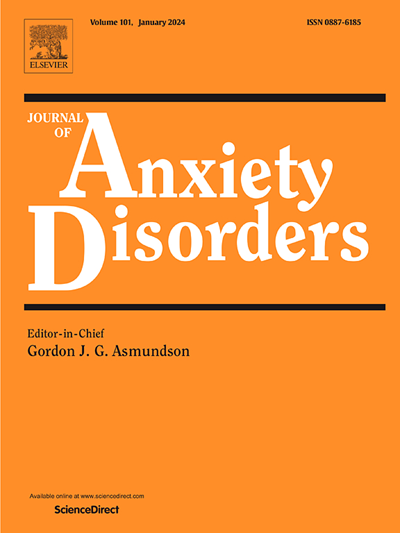老年人广泛性焦虑的外行医师指导下基于cbt的自助:一项随机对照试验
IF 4.5
2区 医学
Q1 PSYCHIATRY
引用次数: 0
摘要
需要治疗广泛性焦虑症(GAD),以绕过老年人获得精神卫生保健的障碍。这项多地点随机对照试验的主要目的是评估由外行提供者(LP)指导的基于cbt的自助治疗老年人广泛性焦虑(即阈值或阈下广泛性焦虑症)的疗效。根据诊断将参与者(≥60岁)分组随机分为实验组(n = 75)或等候名单对照组(n = 75)。实验组的参与者使用一本手册,介绍基于cbt的阅读和练习,并接受有限合伙人每周简短的支持电话。各组在社会人口学特征方面相似,最初在结果上没有显着差异。在治疗后,实验组在两项主要结果(即担忧倾向,p <; )上都有更大的改善。0001,标准化平均差[SMD] = - 1.5971,与GAD严重程度,p <; 。0001, SMD = - 1.1639)和大多数附加结果(例如,目标心理脆弱性、抑郁症状、睡眠困难和广泛性焦虑症诊断)具有小到大的效应量(SMD = - 0.4358至- 1.5402)。在6个月和12个月的随访中,实验组也显示出治疗效果的维持或其他改善。在等待期后完成治疗的对照组参与者在焦虑倾向(SMD = - 1.2477)和GAD严重程度(SMD = - 0.8443)以及大多数其他变量(SMD = - 0.3728至- 1.0154)方面也有所改善。结果表明,LP指导下的自助对治疗老年人广泛性焦虑症是有效的,并且治疗后改善持续。本文章由计算机程序翻译,如有差异,请以英文原文为准。
CBT-based self-help guided by a lay provider for generalized anxiety in older adults: A randomized controlled trial
Treatments for generalized anxiety disorder (GAD) that circumvent the barriers to accessing mental health care in older adults are needed. The main goal of this multisite randomized controlled trial was to evaluate the efficacy of CBT-based self-help guided by a lay provider (LP) for generalized anxiety (i.e., threshold or subthreshold GAD) in older adults. Participants (≥ 60 years) were block randomized based on diagnosis to an experimental (n = 75) or wait-list control group (n = 75). Experimental group participants used a manual presenting CBT-based readings and exercises and received brief weekly support calls by LPs. Groups were similar in terms of sociodemographic characteristics and initially did not differ significantly on outcomes. At post-treatment, the experimental group showed greater improvement across both primary outcomes (i.e., worry tendency, p < .0001, Standardized mean difference [SMD] = −1.5971, and GAD severity, p < .0001, SMD = −1.1639) and most additional outcomes (e.g., targeted psychological vulnerabilities, depressive symptoms, sleep difficulties, and GAD diagnosis) with small to large effect sizes (SMD = −0.4358 to −1.5402). The experimental group also showed maintenance of treatment effects or other improvements at 6- and 12-month follow-up. Participants in the control group who completed the treatment after their waiting period also improved on worry tendency (SMD = −1.2477) and GAD severity (SMD = −0.8443) and most of the other variables (SMD = −0.3728 to −1.0154). Results demonstrate that self-help guided by a LP is effective for treating GAD in older adults and that the improvements are sustained after treatment.
求助全文
通过发布文献求助,成功后即可免费获取论文全文。
去求助
来源期刊

Journal of Anxiety Disorders
Multiple-
CiteScore
16.60
自引率
2.90%
发文量
95
期刊介绍:
The Journal of Anxiety Disorders is an interdisciplinary journal that publishes research papers on all aspects of anxiety disorders for individuals of all age groups, including children, adolescents, adults, and the elderly. Manuscripts that focus on disorders previously classified as anxiety disorders such as obsessive-compulsive disorder and posttraumatic stress disorder, as well as the new category of illness anxiety disorder, are also within the scope of the journal. The research areas of focus include traditional, behavioral, cognitive, and biological assessment; diagnosis and classification; psychosocial and psychopharmacological treatment; genetics; epidemiology; and prevention. The journal welcomes theoretical and review articles that significantly contribute to current knowledge in the field. It is abstracted and indexed in various databases such as Elsevier, BIOBASE, PubMed/Medline, PsycINFO, BIOSIS Citation Index, BRS Data, Current Contents - Social & Behavioral Sciences, Pascal Francis, Scopus, and Google Scholar.
 求助内容:
求助内容: 应助结果提醒方式:
应助结果提醒方式:


